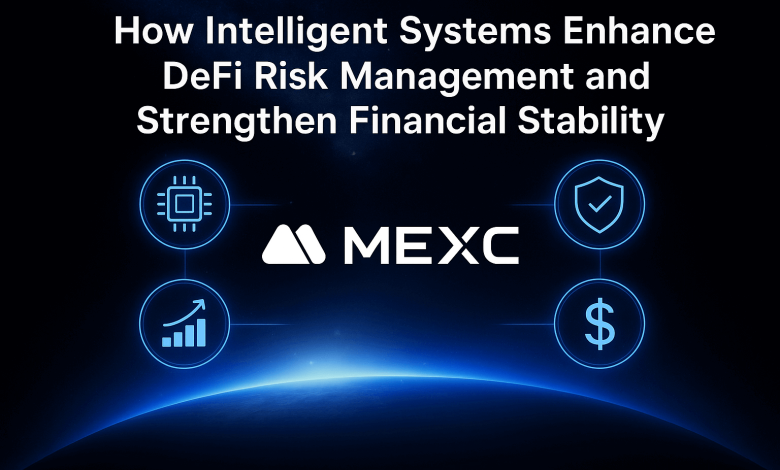
The Evolving Risk Landscape in DeFi
Decentralized Finance (DeFi) has opened a new era of permissionless financial services, allowing users to trade, lend, and earn yields through blockchain-based smart contracts.
Yet this openness brings a complex web of risks, from technical failures to governance breakdowns. As DeFi adoption expands, risk management has become the foundation for long-term ecosystem credibility. This is where artificial intelligence (AI) is emerging as a decisive enabler.
How AI Strengthens DeFi Risk Management
AI brings precision and adaptability to financial risk control by analyzing vast datasets that humans cannot process in real time. Its role in DeFi is to detect, predict, and respond to anomalies before they escalate. Core applications include
- Behavioral anomaly detection
Machine-learning models can identify unusual trading or transaction activity, flagging potential manipulations or exploits across liquidity pools.
- Market-volatility forecasting
Predictive algorithms help anticipate sharp price movements or liquidity shortages, allowing platforms to adjust margin and liquidation thresholds in advance.
- Automated contract evaluation
AI-driven scoring systems can assess the reliability of smart contracts, taking into account code structure, transaction history, and ecosystem exposure.
- Transparent decision logic
Combining blockchain auditability with explainable AI ensures that automated risk actions remain verifiable and accountable.
Instead of replacing human oversight, AI augments it by offering faster detection, evidence-based forecasting, and consistent risk evaluation across decentralized systems.
MEXC’s Framework for DeFi and Risk Governance
MEXC has become one of the few global exchanges that apply institutional-level risk principles to both centralized operations and decentralized integrations. Its approach reflects a balance between innovation and protection, aligning advanced analytics with user safety.
Key initiatives include:
- Exchange Guarantee Fund:
MEXC established an Exchange Guarantee Fund to safeguard users from extreme market fluctuations or unforeseen platform incidents. This reserve mechanism demonstrates a proactive stance on financial stability, ensuring immediate compensation capacity during volatility events.
- Integration with DeFi ecosystems:
Through its initiative on Integration of MEXC with DeFi, the exchange enables users to participate in staking and yield-farming programs while applying centralized-grade oversight to decentralized protocols. This integration bridges traditional exchange controls with open-finance flexibility, minimizing operational and liquidity risks for participants.
- Professional trading risk tools:
In The Survival Blueprint: Professional Risk Management for Crypto Traders on MEXC, the platform highlights AI-assisted order systems, margin protection, and automated liquidation logic tools designed to help traders manage exposure effectively. MEXC’s professional risk framework embodies a transparent, data-driven strategy rooted in measurable safeguards rather than reactive measures.
- Predictive and AI-driven analytics:
MEXC continues to explore AI applications in blockchain-based prediction models and real-time market assessment. Its research outlined in Practical Applications in Prediction and Risk Management shows how intelligent modeling can improve price forecasting, identify emerging risks, and enhance operational resilience across both CEX and DeFi environments.
Together, these measures reflect MEXC’s recognition that DeFi’s long-term success depends not only on innovation speed but also on sustainable, evidence-based risk control.
Building a Smarter and Safer DeFi Future
Effective risk management in DeFi will depend on integrating AI, governance, and education into a unified framework. The next stage of development should focus on several priorities:
1. AI-driven simulation and prediction
Using neural models to stress-test DeFi systems under extreme market conditions.
2. Cross-ecosystem transparency
Encouraging collaboration among exchanges, protocols, and auditing teams to share standardized risk metrics.
3. Explainable AI standards
Ensures that automated decisions remain interpretable, compliant, and auditable.
4. User awareness
Helping investors understand how AI-enhanced monitoring protects their assets and where their responsibilities begin.
5. Continuous model validation
Regularly reviewing AI performance to address data drift or algorithmic bias.
By aligning technological precision with governance discipline, DeFi can evolve from an experimental market into a resilient, intelligent financial ecosystem.
Conclusion
AI has moved from theory to practice in DeFi risk management, becoming a crucial part of how financial platforms predict instability and secure user assets.
MEXC’s ongoing work , from its Exchange Guarantee Fund to its AI-driven research on predictive risk management, shows that a data-centric approach can unite security, transparency, and innovation.
As blockchain finance enters a new phase, combining AI’s analytical depth with DeFi’s openness may define the next standard of trust.
Through intelligent automation and measurable governance, platforms like MEXC are setting that standard, proving that smarter systems create safer finances.

